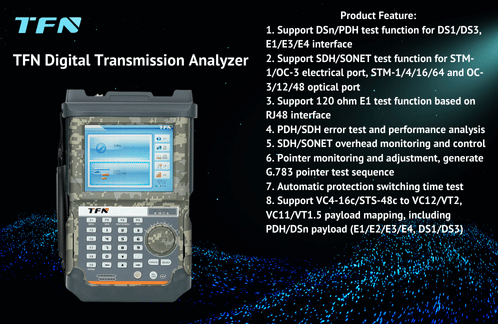What are the main test scenarios for digital transmission analyzers?
As a core test tool for communications networks, digital transmission analyzers are used throughout the network lifecycle. TFN's D-series modular digital transmission analyzers (such as the D240S/D300S/D450S) play an irreplaceable role in four key scenarios thanks to their multi-protocol support, high-precision measurement, and intelligent operation.
1. Network Construction and Commissioning Acceptance
When operators deploy new transmission nodes or expand backbone network capacity, digital transmission analyzers are needed to verify end-to-end performance:
1.1. Physical Layer Testing
Using an optical power meter and jitter analysis functions, they test the transmit power, receive sensitivity, and line loss of 10G/2.5G optical interfaces (XFP/SFP) to ensure compliance with STM-64/STM-16 specifications.
Using electrical interface testing (such as 120Ω E1 or 75Ω DS3), they verify pulse shielding characteristics and impedance matching to prevent signal distortion.
1.2. Protocol Conformance Verification
Configure SDH/SONET overhead bytes, such as inserting J0/J1 trace messages and detecting TIM alarms, to confirm device interoperability.
TFN's intelligent scanning function automatically identifies channel structures and batch tests high-order and low-order path connectivity, improving commissioning efficiency.
2. Fault Diagnosis and Performance Optimization
When faced with network outages or bit error issues, the digital transmission analyzer provides refined troubleshooting:
2.1. Real-Time Alarm Analysis
Monitors key events such as LOS (Loss of Signal), LOF (Loss of Frame), and MS_AIS (Multiplex Section Alarm), and uses historical/current status indicators (H/C) to quickly locate the faulty section.
For example, detecting a persistent HP_SLM (High-Order Path Label Mismatch) alarm indicates a service mapping configuration error.
2.2. Deep Error Tracing
Precisely locates the faulty section using error counters such as BIP-8 (B1/B2/B3) and CRC-4. TFN's enhanced pass-through mode simulates relay equipment behavior and isolates the source of faults.
2.3. Pointer Adjustment Analysis
Counts positive and negative adjustment events for AU/TU pointers to diagnose clock synchronization issues and prevent service code slippage.
3. Network Maintenance and Service Quality Assurance
Operators need to regularly evaluate KPIs to meet SLA commitments. TFN equipment provides standardized performance monitoring solutions:
3.1. G.826/G.828 Standard Performance Statistics
Measure parameters such as ES (Errored Seconds), SES (Severely Errored Seconds), and BBER (Block Error Ratio), generating PDF/HTML reports.
For example, in the core layer of a metropolitan area network, the BBER value of an STM-16 channel is used to assess long-term stability.
3.2. Protection Switching Test
Simulates a fiber break to trigger APS automatic protection (K1/K2 bytes) and verify that the switching time is less than 50ms.
4. New Technology and Hybrid Service Verification
For scenarios such as Ethernet over SDH (EoS) and 5G bearer networks, the TFN digital transmission analyzer provides expanded capabilities:
4.1. Hybrid Service Testing
Uses GFP/VCAT/LCAS functions to carry Ethernet services and combines BERT patterns (PRBS2^23) to verify transmission quality.
4.2. Synchronization Network Testing
Use the AUX external clock interface to test the clock accuracy of 1588v2 or SyncE devices to ensure 5G base station time synchronization.
Why choose the TFN Digital Transport Analyzer?
Modular and flexible adaptability: The D450S (dual-slot) supports 10G span testing, while the D240S (single-slot) is lightweight and suitable for access networks.
Full protocol coverage: Integrated testing for PDH (DS1/E1), SDH (STM-64), and SONET (OC-192).
-
Intelligent operation: Automatic channel scanning and loopback delay measurement reduce labor costs.

Digital transport analyzers have evolved from traditional "troubleshooting tools" to "network quality guardians." Through modular design, multi-protocol integration, and intelligent testing processes, the TFN series precisely meets the construction, maintenance, and evolution requirements of modern communications networks, providing operators and equipment manufacturers with comprehensive solutions for all scenarios.
